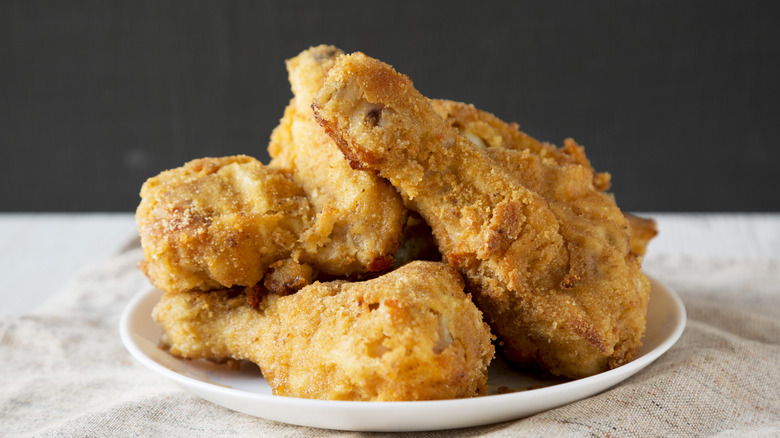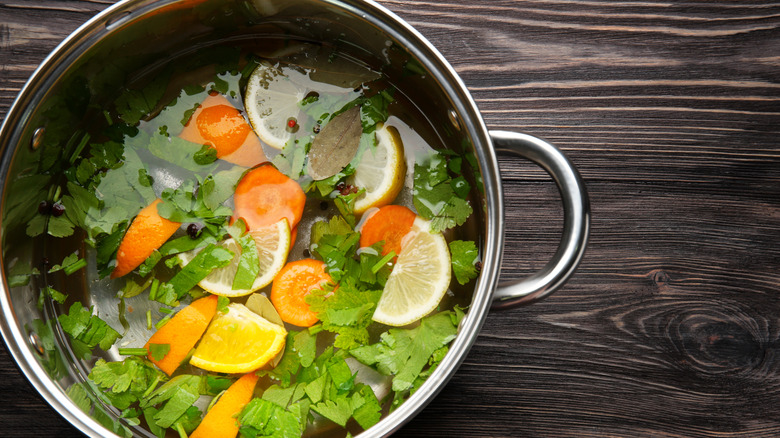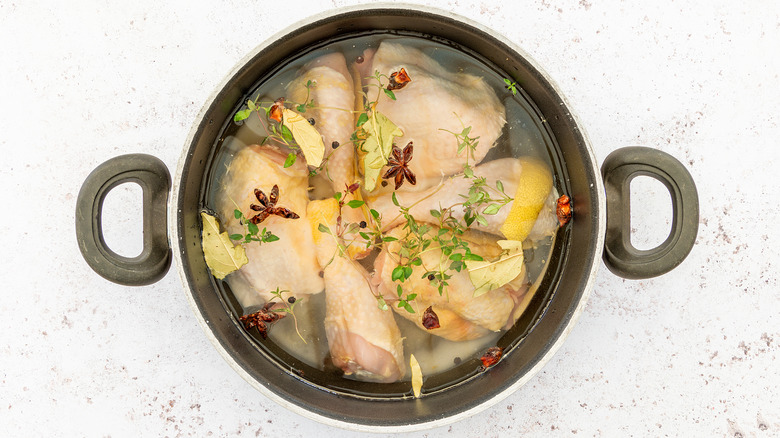For Perfect Oven-Fried Chicken, You Can't Skip The Brine
Chances are that when someone mentions fried chicken, you probably imagine a big pot of ripping hot oil, a whole bunch of grease, and some pretty delicious southern fried chicken. While you're not incorrect in believing that a deep fryer is one of the golden standards of making fried chicken, there are other ways that you can make this poultry-packed dish without using oil or grease — and one of these methods involves your standard kitchen oven.
Making oven-fried chicken from a recipe is exactly what it sounds like: using nothing more than a conventional oven to "fry" your chicken. Although it may not be the "traditional" way of frying up chicken, to say that the oven method doesn't provide a good end result would be untrue. In fact, oven-fried chicken was actually a popular recipe promoted by Kellogg's Cereal in the late 1960s, when the company published a recipe instructing customers to dredge chicken breasts in crushed cornflakes and bake until golden brown (via Click Americana). While cornflakes aren't the only way to ensure a crisp exterior — Ina Garten, for example, uses a classic buttermilk and flour mixture for her oven-fried chicken (via Food Network) — the goal of oven-fried chicken is always the same: a crisp, golden outside with a juicy, flavorful interior instead of a soggy or dried mess.
Fortunately, there's one step that you're already doing when you're making oven-fried chicken that is the key to making the best oven-fried chicken you can prepare.
Don't skimp on the brine
Whenever you make fried chicken, be it in the oven or frying vessel, you likely brine the chicken, or let it soak in a liquid mixture for a while before coating it and seasoning it. While this may seem like so obvious a step that you may not give it a second thought, some claim that this is the foundation on which good oven-fried chicken becomes perfect oven-fried chicken.
Yvonne Ruperti of Serious Eats explains that, although brining does take a long time, focusing on the step helps to ensure a moist and juicy interior instead of a dry, flavorless one. Ruperti allows her chicken to soak in brine for at least four hours or up to overnight. You can experiment with different types of brine (Ruperti tried a salt and sugar brine and a buttermilk brine) as long as the chicken is allowed a moderate amount of time to soak in it. Meanwhile, Leite's Culinaria tried Amanda Hesser's mom's oven-fried chicken and found that the brine also helps to crisp up the bird's skin.
The reason why brining is so critical is because, as America's Test Kitchen explains, the process of brining changes the protein structure of the meat to allow it to hold more moisture. As the meat absorbs the liquid in the brine, the salt in the brine helps to ensure that the collective moisture isn't lost even when the chicken is being fried or baked in the oven.
What are the best ways to brine your chicken?
Aside from learning why you need to brine, you should also be mindful that your entire chicken — from thighs to drumsticks — gets "maximum soakage." What are the best ways to make sure that your bird gets as much exposure to the brine as possible?
According to Chicken Farmers of Canada, a good general rule to keep in mind is that a chicken should brine every one hour per pound of meat, though this is merely an estimate and can be changed based on factors such as salt level or flavor. The best way to brine your chicken, reportedly, is to use a large stock pot and fill it with brine to ensure that the chicken, be it whole or divided, has enough room to soak. Too small of a container means that areas of the chicken will be above the brine instead of submerged in it.
Rouxbe also explains that, when selecting a container for use in brining, one must make sure the container is both spacious and food safe. Examples include glass bowls, plus both ceramic and stainless steel stock pots, as they are all safe to use when preparing food. While sealable plastic bags are similarly appropriate, Rouxbe suggests skipping larger bags like trash bags to avoid any chemicals within plastic not suitable for food preparation.
In short, a large container and a few hours can go a long way toward making an oven-fried chicken its juiciest.


